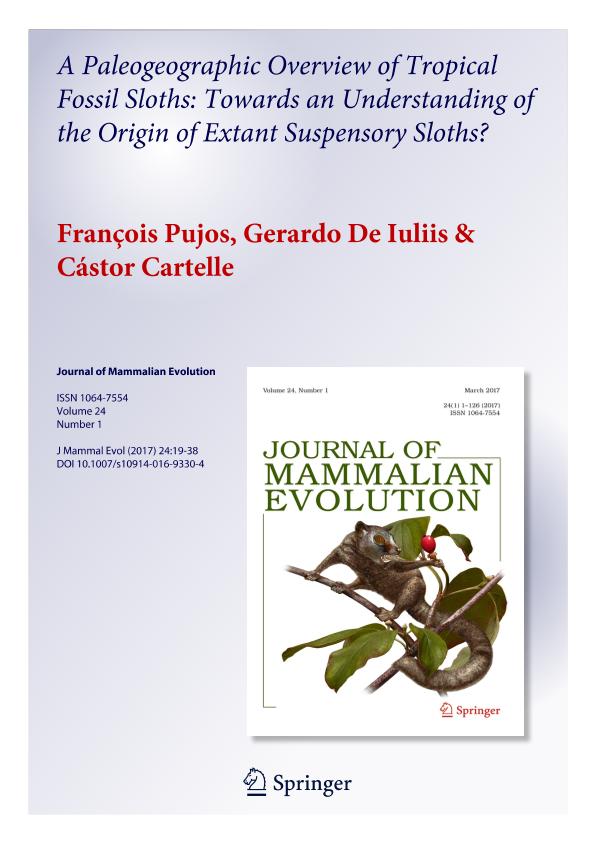Mostrar el registro sencillo del ítem
dc.contributor.author
Pujos, François Roger Francis

dc.contributor.author
De Iuliis, G.
dc.contributor.author
Cartelle, C.
dc.date.available
2018-11-01T18:12:25Z
dc.date.issued
2017-03
dc.identifier.citation
Pujos, François Roger Francis; De Iuliis, G.; Cartelle, C.; A Paleogeographic Overview of Tropical Fossil Sloths: Towards an Understanding of the Origin of Extant Suspensory Sloths?; Springer; Journal of Mammalian Evolution; 24; 1; 3-2017; 19-38
dc.identifier.issn
1064-7554
dc.identifier.uri
http://hdl.handle.net/11336/63466
dc.description.abstract
Modern sloths are among the more characteristic mammals of South and Central American faunas. Recent discovery in four Paleogene, 22 Neogene, and dozens of Pleistocene fossiliferous localities in the tropics has revealed an unexpected paleobioversity constituted by some 81 fossil sloth species. Probably originating in southern South America near the Eocene/Oligocene transition, sloths were represented in the tropics during the late Oligocene by Pseudoglyptodon, Mylodontidae, and Megalonychidae. The latter occupied the West Indies between at least the late early Miocene and late Pleistocene, and two mylodontid clades, Octodontobradyinae and Urumacotheriinae, were characteristic of Amazonian localities from the Colhuehuapian and the Laventan periods, respectively, until the end of the Miocene. Megatheriinae and Nothrotheriidae appeared during the middle Miocene, colonizing the tropics and then North America, where Mylodontidae and Megalonychidae had already been present since the early late Miocene. Nothrotheriids are more abundant and diversified during the late Miocene in the tropics than in southern South America. Remains closely related to either of the modern sloths are absent from the fossil record, including those in the tropics. The characteristic suspensory posture of Bradypus and Choloepus appeared independently and likely after the Miocene epoch, and thus well after the hypothesized split suggested by molecular studies of the respective clades of these genera. Given their current widespread distribution in and reliance on the tropics, prospecting efforts for the direct fossil kin of suspensory sloths should concentrate on deposits in the Amazonian region, as this area has shown promise in producing fossil sloths.
dc.format
application/pdf
dc.language.iso
eng
dc.publisher
Springer

dc.rights
info:eu-repo/semantics/openAccess
dc.rights.uri
https://creativecommons.org/licenses/by-nc-sa/2.5/ar/
dc.subject
Neogene
dc.subject
Paleogene
dc.subject
Pleistocene
dc.subject
Sloths
dc.subject
Systematics
dc.subject
Tropics
dc.subject.classification
Paleontología

dc.subject.classification
Ciencias de la Tierra y relacionadas con el Medio Ambiente

dc.subject.classification
CIENCIAS NATURALES Y EXACTAS

dc.title
A Paleogeographic Overview of Tropical Fossil Sloths: Towards an Understanding of the Origin of Extant Suspensory Sloths?
dc.type
info:eu-repo/semantics/article
dc.type
info:ar-repo/semantics/artículo
dc.type
info:eu-repo/semantics/publishedVersion
dc.date.updated
2018-10-23T14:41:26Z
dc.identifier.eissn
1573-7055
dc.journal.volume
24
dc.journal.number
1
dc.journal.pagination
19-38
dc.journal.pais
Alemania

dc.journal.ciudad
Berlin
dc.description.fil
Fil: Pujos, François Roger Francis. Consejo Nacional de Investigaciones Científicas y Técnicas. Centro Científico Tecnológico Conicet - Mendoza. Instituto Argentino de Nivología, Glaciología y Ciencias Ambientales. Provincia de Mendoza. Instituto Argentino de Nivología, Glaciología y Ciencias Ambientales. Universidad Nacional de Cuyo. Instituto Argentino de Nivología, Glaciología y Ciencias Ambientales; Argentina
dc.description.fil
Fil: De Iuliis, G.. University of Toronto; Canadá. Royal Ontario Museum; Canadá
dc.description.fil
Fil: Cartelle, C.. Pontifícia Universidade Católica de Minas Gerais
; Brasil
dc.journal.title
Journal of Mammalian Evolution

dc.relation.alternativeid
info:eu-repo/semantics/altIdentifier/doi/http://dx.doi.org/10.1007/s10914-016-9330-4
dc.relation.alternativeid
info:eu-repo/semantics/altIdentifier/url/https://link.springer.com/article/10.1007%2Fs10914-016-9330-4
Archivos asociados
